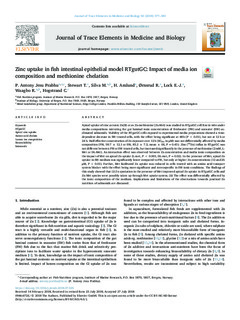| dc.contributor.author | Prabhu, Antony | |
| dc.contributor.author | Stewart, Theodora | |
| dc.contributor.author | Carreiro-Silva, Marina | |
| dc.contributor.author | Amlund, Heidi | |
| dc.contributor.author | Ørnsrud, Robin | |
| dc.contributor.author | Lock, Erik-Jan | |
| dc.contributor.author | Waagbø, Rune | |
| dc.contributor.author | Hogstrand, Christer | |
| dc.date.accessioned | 2018-10-08T14:44:50Z | |
| dc.date.available | 2018-10-08T14:44:50Z | |
| dc.date.created | 2018-08-28T13:20:38Z | |
| dc.date.issued | 2018 | |
| dc.identifier.citation | Journal of Trace Elements in Medicine and Biology. 2018, 50 377-383. | nb_NO |
| dc.identifier.issn | 0946-672X | |
| dc.identifier.uri | http://hdl.handle.net/11250/2566969 | |
| dc.description.abstract | Apical uptake of zinc as ionic Zn(II) or as Zn-methionine (Zn-Met) was studied in RTgutGC cell line in vitro under media compositions mirroring the gut luminal ionic concentration of freshwater (FW) and seawater (SW) acclimated salmonids. Viability of the RTgutGC cells exposed to experimental media preparations showed a time-dependent decrease in SW treated cells, with the effect being significant at 48 h (P < 0.01), but not at 12 h or 24 h. Half effective concentration of Zn exposure over 12 h (EC50, in μM) was not differentially affected by media composition (FW, 59.7 ± 12.1 or SW, 83.2 ± 7.2; mean ± SE, P = 0.43). Zinc (65Zn) influx in RTgutGC was not different between FW or SW treated cells, but increased significantly in the presence of methionine (2 mM, L-Met or DL-Met). An interaction effect was observed between Zn concentration and media ionic composition on the impact of Met on apical Zn uptake (L-met, P < 0.001; DL-met, P = 0.02). In the presence of Met, apical Zn uptake in SW medium was significantly lower compared to FW, but only at higher Zn concentrations (12 and 25 μM, P < 0.01). Further, Met facilitated Zn uptake was reduced in cells treated with an amino acid transport system blocker with the effect being more significant and stereospecific in SW ionic conditions. The findings of this study showed that (i) Zn speciation in the presence of Met improved apical Zn uptake in RTgutGC cells and Zn-Met species were possibly taken up through Met uptake system. (ii) The effect was differentially affected by the ionic composition of the medium. Implications and limitations of the observations towards practical Zn nutrition of salmonids are discussed. | nb_NO |
| dc.language.iso | eng | nb_NO |
| dc.title | Zinc uptake in fish intestinal epithelial model RTgutGC: Impact of media ion composition and methionine chelation | nb_NO |
| dc.title.alternative | Zinc uptake in fish intestinal epithelial model RTgutGC: Impact of media ion composition and methionine chelation | nb_NO |
| dc.type | Journal article | nb_NO |
| dc.type | Peer reviewed | nb_NO |
| dc.description.version | publishedVersion | nb_NO |
| dc.source.pagenumber | 377-383 | nb_NO |
| dc.source.volume | 50 | nb_NO |
| dc.source.journal | Journal of Trace Elements in Medicine and Biology | nb_NO |
| dc.identifier.doi | 10.1016/j.jtemb.2018.07.025 | |
| dc.identifier.cristin | 1604981 | |
| dc.relation.project | Norges forskningsråd: 244490 | nb_NO |
| cristin.unitcode | 7431,31,0,0 | |
| cristin.unitcode | 7431,0,0,0 | |
| cristin.unitcode | 7431,32,0,0 | |
| cristin.unitcode | 7431,1,0,0 | |
| cristin.unitname | Behov og velferd | |
| cristin.unitname | Havforskningsinstituttet | |
| cristin.unitname | Trygt fôr | |
| cristin.unitname | Ledelse | |
| cristin.ispublished | true | |
| cristin.fulltext | original | |
| cristin.qualitycode | 1 | |
